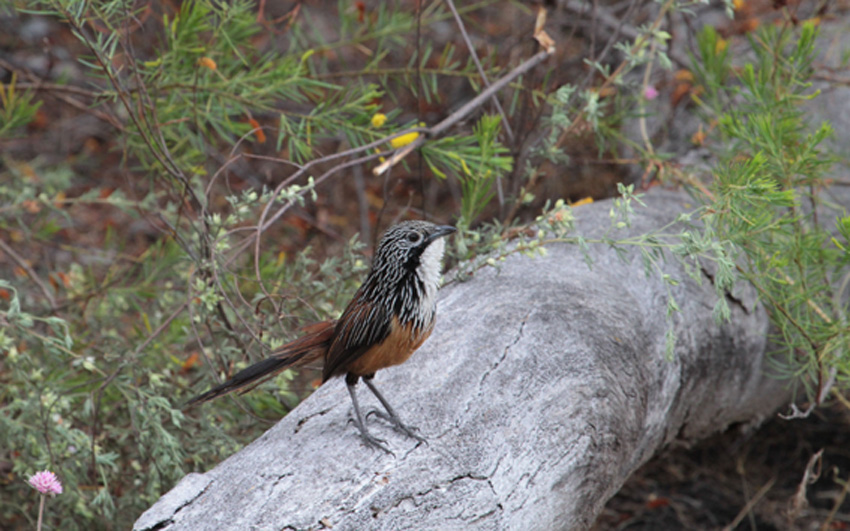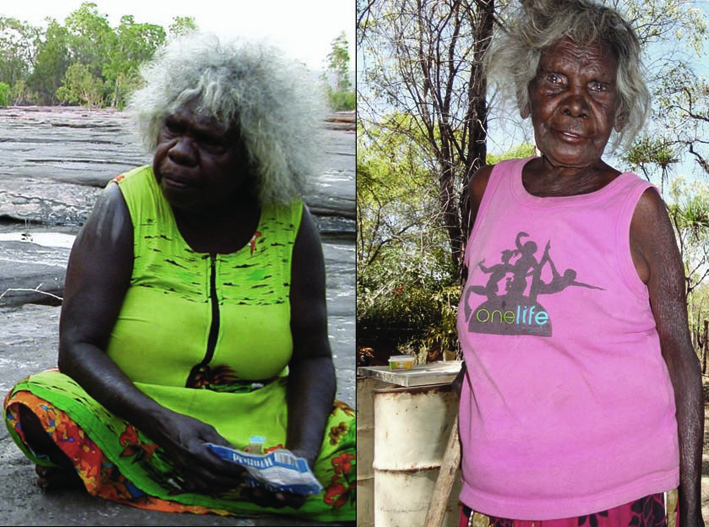Yirlinkirrkkirr / Djirnidjirnirrinjken
White-throated Grass Wren
September 8, 2012This post is about a bird endemic to the rock country of Bininj Gunwok speaking people— the white-throated grass wren (Amytornis woodwardi) or yirlinkirrkkirr (in most dialects). In Kune dialect it is called djirnidjirnirrinjken.
Nahni ngurriwokbekkan kobohbanj banibokenh kabarriyolyolme bu yirlinkirrkkirrk-ken.

photo © Warddeken Land Management Ltd and Peter Cooke.
Click on the audio to hear how to pronounce yirlinkirrkkirr or the Kune version djirnidjirnirrinjken.
Yirlin-kirrk-kirr
Djirni-djirnirrinj-ken
Nakangila Ivan Namarnyilk: Nane namekke kikkik name kangeyyo, njamed namekke, ngarringeybun nanih, djirnidjirnirrinjken, djirnidjirnirrinjken.
Nakangila Ivan Namarnyilk: This bird has a name and this is how we say its name— (repeated)
djirnidjirnirrinjken, djirnidjirnirrinjken
In the following 4 audio files and transcript, you can hear two senior knowledgeable women Kodjdjan Mary Naborlhborlh and Kodjdjan Mary Kolkkiwarra talking to their grandson and Warddeken land management ranger Nakamarrang Gavin Namarnyilk as he seeks to learn something about this special little bird only found in the rock country of Western Arnhem Land and Kakadu National Park.
[00:00:00.00] Yirlinkirrkkirr
[00:00:01.22] GN: Bale kore karri bale kabolkyime laik yimulewa.
Where does it live, can you say something about it.
[00:00:05.00] MK: Kuwarddewardde karri.
It lives in the rock country.
[00:00:08.01] MK: Yiman kayime Kamarrkawarn karri kore kanjdjikanjdji, ankebkakebkali.
You can find them at Kamarrkawarn down on the river by the edge of the rocks where they meet the savanna.
[00:00:13.10] MK: Yiman kayime anywhere yiman kayime mani any side kore malayi wanjh start moving ngurrimang ngurrire.
Anywhere there, such as any side (near the rocks) so tomorrow when you start moving around there, that's where you go.
[00:00:20.21] MN: Yo
[00:00:21.12] MK: Kare kumeke kuwarddewardde ngurribekkan kayime "yirlinkirrk-kirrk-kirrk-kirrk" kawokdi.
In that rock country there, listen out for the call "yirlinkirrk-kirrk-kirrk-kirrk".
[00:00:24.00] MN: "yirlinkirrk-kirrk-kirrk-kirrk" kayime kawokdi...nungka.
It goes like that, "yirlinkirrk-kirrk-kirrk-kirrk", that's him.
[00:00:26.18] MK: Kamulewarren nakka woybuk namekke ngaleng ngurrimang name yirlinkirrkkir.
He is saying who he is; for sure you'll be able to find one, the white-throated grass wren.
[00:00:30.11] MN: Yo
[00:00:31.00] GN: mm
[00:00:32.00] MN: kamulewarren.
He's saying who he is (talking about himself).
[00:00:32.19] MK: Nanih (?) namekke kabimdihbimdi yirlinkirrkkirr nakka.
These pictures here (computer) are the white-throated grass wren.
[00:00:35.05] MN: Dja kune nawu dedjmudkuyengkuyeng.
And it has very long tail feathers.
[00:00:38.19] MK: Nahni.
This one.
[00:00:40.16] MN: Nane (something) njalenjale
and various other features
[00:00:42.01] MK: Namekkengong wanjh name yirlinkirrkkirr.
These birds (in the photos) are all the white-throated grass wren.
[00:00:42.22] MN: namekke nahni, ngoyo?? nani nawu
that one there, that's him
[00:00:45.15] GN: So Kamarrkawarn karri konda karri?
So it lives here at Kamarrkawarn?
[00:00:48.08] MK: Konda karri.
It lives around here.
[00:00:49.11] MN: Nganmoyi karri...konda karri.
It's also at Manmoyi... it lives here.
[00:00:50.24] MK: Wardi konda bu kare karri bad...
It must also be living around here...
[00:00:55.07] MK: wardi ngurridjalyawayawan dja ngaye mak ngadjalyime bu marrek kareh karri wardi o maitbi, karri, because kuwardde karri nakka.
Just try and have a look around. I'm only assuming you'll find there because it's the right kind of habitat in the rock country there.
[00:01:01.24] MN: mm karri ngurribekkan kawokdiwokdi.
It's there, just listen out for its call.
[00:01:03.07] MK: Mani Ankung Djang area kanjdji karri ankebkali yirlinkirrkkirr
It's also in the Ankung Djang (Honey Dreaming) area on the lowland areas by the edge of rocky escarpment lines, the white-throated grass wren.
[00:01:06.16] MN: Karri
It's there.
[00:01:07.23] MK: Ngurrire ngurringalke.
Go there and you will find it.
[00:01:10.04] GN: Try namekke malayi ngarrire ngarriyawan ane ngaleh ngandibidyikarrme.
We'll try to go there tomorrow and look for it but we need your help (two elders).
[00:01:17.01] MN: Yo wanjh ngurriyawan ngurribekkan kawokdiwokdi.
Yes, go then and listen to its call when you are looking for it.
[00:01:20.21] MN: Bu karriwokbekkan. Kawokdi nungkakih. (song)
Let's listen to it talking (on audio recording). It will speak, that's it now.
[00:01:29.01] MK: Yirlinkirrkkirr!
White-throated grass wren!
[00:01:29.19] MN: Nungkakih
That's it now.
[00:01:30.21] (kawokdi yirlinkirrkkirr)
(the white-throated grass wren calls)
[00:01:35.19] GN: (to ecologist Alys Stevens) Where did you record it?
[00:01:37.00] Alys: Kakadu
[00:01:40.01] MN: Nungkakih
That's it now.
[00:01:43.02] GN: Yiwokbekkang?
Can you hear it speaking?
[00:01:44.19] (kawokdi Yirlinkirrkkirr yerre)
(the white-throated grass wren still singing)
[00:01:44.19] MN: Med yibekkan.
Hang on, listen.
[00:01:48.08] (bird)
[00:01:53.06] MN: Nungkakih ... yibekkan.
Listen... that's it now!
[00:01:56.12] MK: Kore kuwardde bawokmangi o bale kungarre?
Where did she (Alys) record it— in the rock country or where, in a thicket?
[00:01:59.03] GN: Kakadu.
[00:01:59.15] MK: Kungarre?
In thick bush?
[00:02:00.10] Alys: Gunlom
[00:02:01.17] All: Gunlom
[00:02:03.10] MN: Gunlom bawokmey.
She recorded it at Gunlom.
[00:02:04.16] GN: Gunlom bawokmey.
She recorded it at Gunlom.
[00:02:05.19] MK: Nungkakih
That's it now.
[00:02:06.10] Ngalbuyika: Nungkakih
That's it now.
[00:02:08.24] MN: mm nungkakih
mm, that's it now.

If you only want to hear the song of yirlinkirrkkirr, click below:
Thanks to Alys Stevens from the Biodiversity Conservation Unit, Northern Territory Government for making these recordings and to the two Kodjdjan, Mary Kolkkiwarra (left) and Mary Naborlhborlh (right) for their knowledge about the birds. Thanks also to Peter Cooke for the excellent yirlinkirrkkirr photo and to Maningrida Djelk Ranger Ivan Namarnyilk for the Kune pronunciation.
Bonj
That is all.